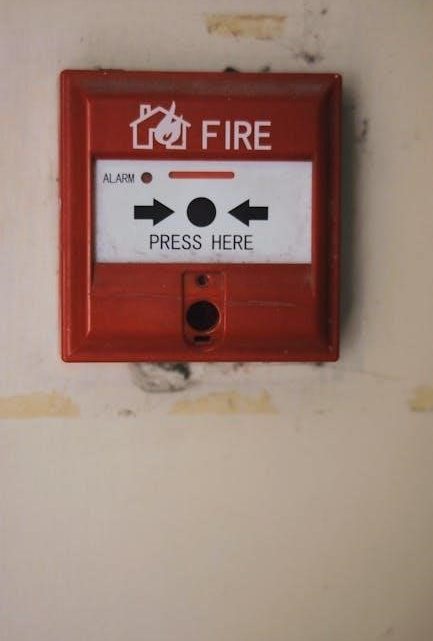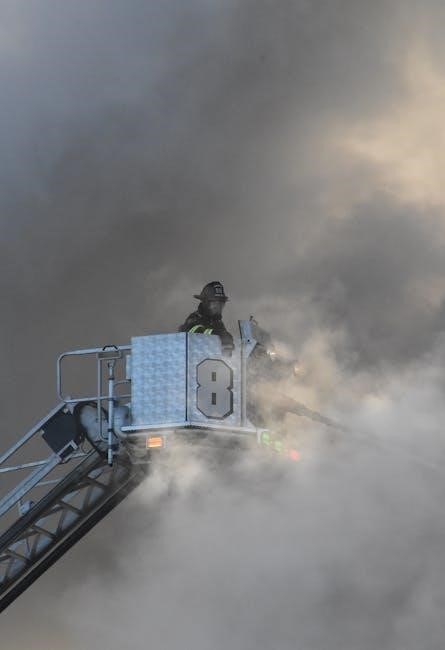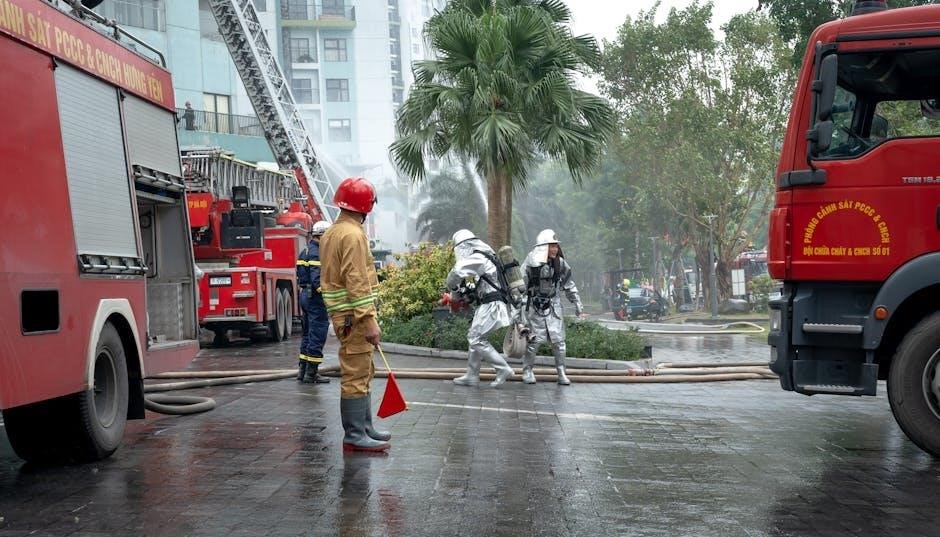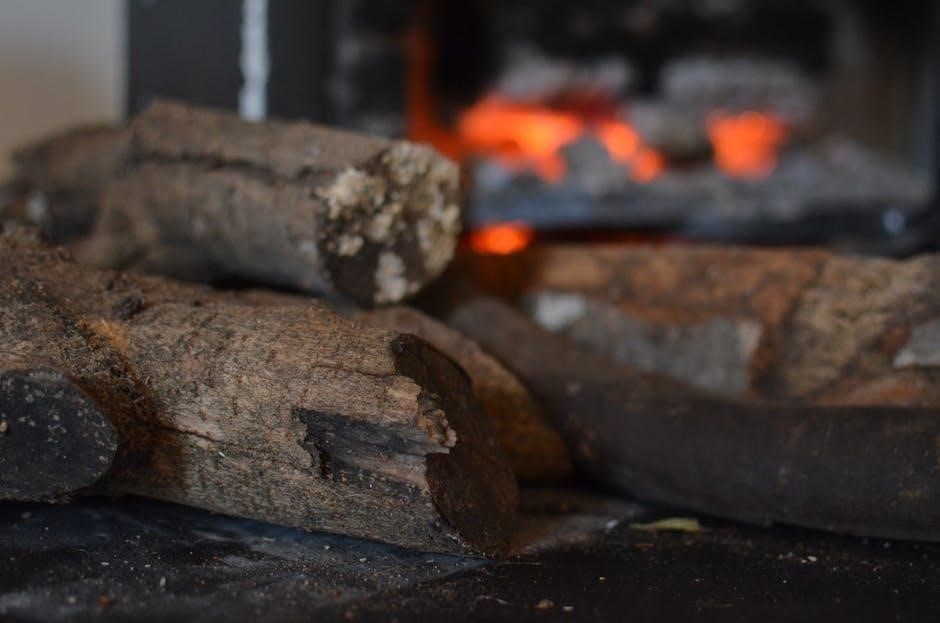
first alert carbon monoxide and smoke alarm manual
Introducing the First Alert Carbon Monoxide and Smoke Alarm, a state-of-the-art device providing early warnings for fires and CO. Offers dual protection, smart app connectivity, and a silence feature for false alarms, ensuring comprehensive home safety.
Overview of the First Alert Carbon Monoxide and Smoke Alarm
The First Alert Carbon Monoxide and Smoke Alarm is a cutting-edge safety device designed to detect both smoke and carbon monoxide in a single unit. It combines advanced sensors to provide early warnings for fires and CO leaks, offering comprehensive protection for homes. With features like smart app connectivity, battery backup, and compliance with UL217 standards, it ensures reliable performance and peace of mind for users.
Importance of Having a Combination Smoke and CO Alarm
A combination smoke and CO alarm offers dual protection, detecting both fire and carbon monoxide threats in one device. This ensures early detection of deadly hazards, providing critical time to escape. It simplifies installation, reduces costs, and streamlines maintenance compared to separate units. With features like smart alerts and silence options, it enhances safety and convenience, making it a vital addition to any home’s safety system.

Key Features of the First Alert Carbon Monoxide and Smoke Alarm
The First Alert Carbon Monoxide and Smoke Alarm features dual protection, silence functionality, battery backup, smart app connectivity, and compliance with UL217 standards for enhanced home safety.
Dual Protection Against Smoke and Carbon Monoxide
The First Alert Carbon Monoxide and Smoke Alarm offers dual protection by detecting both smoke and carbon monoxide in a single unit. This combination alarm eliminates the need for separate devices, providing comprehensive safety. It uses advanced sensors to detect particles of combustion for smoke and harmful CO levels, ensuring early warnings for both threats. With UL217 certification, it meets rigorous safety standards, offering reliable protection and peace of mind for homeowners.
Silence Feature for False Alarms
The Silence Feature on the First Alert Carbon Monoxide and Smoke Alarm allows users to temporarily mute false alarms caused by cooking, steam, or other non-emergency situations. By pressing the test/silence button, the alarm is quieted for several minutes, providing convenience without compromising safety. This feature ensures that homeowners are not disturbed by unnecessary alerts while maintaining reliable protection against actual threats. It’s a practical solution for reducing false alarms while keeping the alarm fully functional.
Battery Backup and AC-Powered Options
The First Alert Carbon Monoxide and Smoke Alarm offers flexible power options, including battery backup and AC-powered models; Battery-powered alarms provide continuous protection during power outages, while AC-powered models offer reliable performance with a battery backup for added safety. This dual-power capability ensures uninterrupted monitoring, giving homeowners peace of mind. The combination of these options allows for tailored installation to meet specific household needs while maintaining superior protection against smoke and carbon monoxide threats.
Smart App Connectivity for Remote Alerts
The First Alert Carbon Monoxide and Smoke Alarm integrates seamlessly with the First Alert app, enabling remote alerts for smoke or CO detection. This feature allows users to receive real-time notifications on their smartphones, whether at home or away. The app enhances fire and carbon monoxide safety by providing instant alerts, ensuring prompt action can be taken. Compatible with smart home systems, this connectivity offers an advanced layer of protection and peace of mind.
Compliance with Regulatory Standards (UL217)
The First Alert Carbon Monoxide and Smoke Alarm adheres to UL217 standards, ensuring reliable detection of smoke and carbon monoxide. These standards guarantee the alarm’s performance in detecting combustion particles and CO levels. Compliance with UL217 ensures the device meets rigorous safety requirements, providing accurate alerts and protecting homes effectively. This certification underscores the alarm’s trustworthiness and ability to deliver life-saving notifications when threats are present.

Models and Specifications
Explore various First Alert models like the PC910, CO600A, SC9120B, and SCO5, each offering unique features such as combination detection, silence functionality, and smart connectivity options.
PC910 ౼ Combination Carbon Monoxide & Smoke Alarm
The PC910 is a reliable combination alarm detecting both smoke and carbon monoxide. It features a loud 85-decibel warning, LED indicators, and meets UL standards for safety. With a battery backup, it ensures protection even during power outages. The alarm provides clear voice alerts for smoke or CO detection, making it user-friendly. Its compact design and easy installation make it a practical choice for whole-house safety. Replace batteries annually and the sensor every 10 years for optimal performance.
CO600A ౼ 120V Plug-In Carbon Monoxide Alarm with Silence Feature
The CO600A is a 120V plug-in carbon monoxide alarm designed for reliable detection of dangerous CO levels. It features an electrochemical sensor, LED indicators, and a silence button to mute false alarms. With UL certification, it ensures compliance with safety standards. The plug-in design allows easy installation, and the alarm provides clear voice alerts for CO detection. Replace the unit every 10 years for optimal performance and continued protection against carbon monoxide threats.
SC9120B ౼ AC Powered Smoke & Carbon Monoxide Alarm
The SC9120B is an AC-powered smoke and carbon monoxide alarm with a battery backup, ensuring continuous protection during power outages. It features a latching alarm for easy identification of the triggering hazard and a silence button to mute false alarms. The alarm includes LED indicators for status updates and meets UL217 standards for safety. Designed for installation on every level and in bedrooms, it provides early detection of smoke and CO threats, with a 10-year replacement recommendation for optimal functionality.
SCO5 ⎯ Combination Smoke & Carbon Monoxide Alarm
The SCO5 is a reliable combination smoke and carbon monoxide alarm designed for seamless protection. It uses photoelectric sensors for smoke detection and electrochemical sensors for CO detection, providing accurate alerts. Battery-powered for easy installation, it features a silence button to mute false alarms and LED indicators for status updates. Meeting UL standards, the SCO5 offers a user-friendly design with clear alerts and a 10-year sensor lifespan, ensuring safety and convenience for homeowners.

Installation and Setup
Ensure proper placement by installing alarms on every level and in every bedroom, at least 12 inches from walls. Avoid areas near cooking appliances to minimize false alarms.
Where to Install Smoke and Carbon Monoxide Alarms
Install smoke and carbon monoxide alarms on every level of your home, including the basement, and in every bedroom. Place them at least 12 inches away from walls and avoid areas near cooking appliances to reduce false alarms. For carbon monoxide alarms, install them near sleeping areas and on each level, especially near fuel-burning appliances like furnaces or water heaters. Ensure whole-house protection by covering all living spaces.
How to Install Hardwired and Battery-Powered Models
For hardwired models, turn off the power at the circuit breaker, connect the wires to the alarm, and mount it securely. Restore power and test the alarm. For battery-powered models, insert the batteries, attach the alarm to its bracket, and ensure it’s level. Test the alarm after installation. Always follow the manufacturer’s instructions and ensure proper placement for reliable performance and safety.
Connecting Multiple Alarms for Whole-House Protection
For enhanced safety, connect multiple First Alert alarms to ensure whole-house protection. Hardwired models can be interconnected via wiring, while wireless units sync through a simple process. This ensures all alarms sound simultaneously upon detection, providing comprehensive coverage. Always follow the manual’s instructions for proper interconnection and compatibility to maintain reliable performance and whole-home safety.

Maintenance and Troubleshooting
Regularly clean the alarm using a vacuum cleaner and test it monthly. Check error codes and LED indicators for troubleshooting. Resolve false alarms by silencing or resetting.
Cleaning and Testing the Alarm
Regular cleaning is essential for optimal performance. Use a vacuum cleaner to gently remove dust and debris from the alarm’s sensors and exterior. Test the alarm monthly by pressing the test button to ensure it sounds. Check for any error codes or LED indicators that may signal a issue. Cleaning ensures the sensor remains sensitive to smoke and CO, while testing confirms the alarm is functioning correctly. This routine maintenance helps protect your home and family effectively.
Understanding Error Codes and LED Indicators
The First Alert Carbon Monoxide and Smoke Alarm uses LED indicators and error codes to signal status and issues. A steady green LED indicates normal operation, while a red LED flashing signals an alarm. Error codes like “E1” or “E2” may appear, indicating specific problems such as low battery or sensor issues. Refer to the manual for code meanings and solutions. Addressing these alerts ensures the alarm functions correctly and maintains your home’s safety. Regular checks help prevent false alarms and ensure reliability;
Resolving Common Issues Like False Alarms
False alarms can be resolved by pressing the silence feature or resetting the alarm. Ensure the device is clean and free from dust. If issues persist, check for proper installation and avoid placing alarms near cooking areas or steam sources. Regular testing and maintenance, as outlined in the manual, help minimize false alarms. Addressing these issues promptly ensures reliable performance and home safety. Always refer to the manual for troubleshooting guidance. Regular checks prevent recurring problems.

Safety Tips and Best Practices
Install First Alert Alarms on every level and in every bedroom for maximum protection. Replace alarms every 10 years and test monthly. Avoid placing alarms near cooking areas to reduce false alarms. Ensure proper installation and maintenance for reliable performance and home safety.
Why You Need Alarms on Every Level and in Every Bedroom
Installing First Alert Alarms on every level and in each bedroom ensures comprehensive protection against smoke and carbon monoxide. These deadly threats can spread quickly, and having alarms in strategic locations provides life-saving early warnings. Bedrooms and multiple levels require coverage to alert occupants promptly, regardless of where a fire or CO leak occurs, ensuring safe evacuation and maximizing home safety.
How to Respond to Smoke or Carbon Monoxide Alerts
When your First Alert Alarm sounds, evacuate immediately and do not investigate the source. Open windows for ventilation if safe, but prioritize exiting the premises. Once outside, call emergency services and await professional clearance before re-entering. Never ignore alerts, as they indicate a potential threat to your safety. Prompt action ensures the well-being of everyone in the household.
Replacing Alarms Every 10 Years
Replace your First Alert Smoke and CO Alarms every 10 years to ensure optimal performance and safety. Check the expiration date on the alarm or in the manual. Failing to replace expired alarms can reduce their effectiveness in detecting threats. Models like the SCO5 and SC9120B have clear expiration indicators. Regular replacement is crucial for maintaining reliable protection against smoke and carbon monoxide hazards in your home.

Differences Between Smoke and Carbon Monoxide Alarms
Smoke alarms detect particles from combustion, while carbon monoxide alarms sense CO gas levels. Both are crucial but serve distinct purposes in home safety, making a combination alarm ideal for comprehensive protection.
What Smoke Alarms Detect
Smoke alarms detect particles of combustion, such as smoke from fires, by sensing variations in airflow or light scattering. They are designed to identify fires early, even before they spread. Smoke particles can vary in size, and modern alarms are engineered to detect both small and large particles effectively. Smoke alarms are not designed to detect carbon monoxide or other gases, making them specialized for fire safety. Regular testing ensures they remain reliable for early fire detection.
What Carbon Monoxide Alarms Detect
Carbon monoxide alarms detect dangerous levels of CO gas, which is odorless, colorless, and deadly. They monitor the air for CO concentrations and trigger alerts when unsafe levels are detected. These alarms are specifically designed to sense CO from any source, providing early warnings to protect against CO poisoning. Unlike smoke alarms, CO detectors do not respond to smoke, heat, or flames, ensuring accurate alerts for gas leaks only. Prompt evacuation is crucial when an alarm sounds.
Why a Combination Alarm is More Effective
A combination smoke and carbon monoxide alarm offers dual protection in one device. It detects both smoke and CO, providing comprehensive safety against two deadly threats. This eliminates the need for separate alarms, simplifying installation and maintenance. With features like app connectivity, you receive real-time alerts for both dangers, ensuring immediate action. This integrated approach enhances home safety, offering peace of mind and reducing the risk of missed alerts from standalone detectors.

Frequently Asked Questions
Discover answers to common queries about First Alert Carbon Monoxide and Smoke Alarms, including resetting, battery replacement, and expiration dates for optimal functionality and safety.
How to Reset the Alarm
To reset your First Alert Carbon Monoxide and Smoke Alarm, press and hold the test button for at least 10 seconds. This action will reset all Z-Wave settings and silence the alarm. Ensure no smoke or carbon monoxide is present before resetting to avoid false alarms. Regular resetting helps maintain proper functionality and ensures your safety. Refer to the manual for detailed instructions.
How to Replace Batteries
To replace batteries in your First Alert Carbon Monoxide and Smoke Alarm, turn off the power supply if hardwired. Remove the battery compartment, typically located on the back or side of the unit. Replace the old batteries with new ones of the correct type (e.g., AA or 9V). Reattach the compartment and restore power. Test the alarm by pressing the test button to ensure it works properly. Replace batteries annually or when the low-battery warning sounds.
How to Check Alarm Expiration Dates
To check the expiration date of your First Alert Carbon Monoxide and Smoke Alarm, locate the label on the back or side of the unit. The expiration date is typically printed and indicates when the alarm should be replaced. Refer to the manual for specific guidelines. Most alarms expire after 10 years from manufacture, ensuring optimal performance and safety. Replace promptly to maintain reliable protection.
The First Alert Carbon Monoxide and Smoke Alarm is an essential device for home safety, offering reliable protection and peace of mind. Regular maintenance and testing ensure optimal performance, while replacement every 10 years guarantees continued safety. Invest in a First Alert alarm for comprehensive protection against smoke and carbon monoxide threats.

Final Thoughts on the Importance of Smoke and CO Alarms
Smoke and carbon monoxide alarms are indispensable for safeguarding lives and property. They provide early warnings, enabling timely evacuations. First Alert alarms excel by combining smoke and CO detection, ensuring dual protection. Smart app connectivity enhances safety by sending remote alerts; Compliance with UL217 standards guarantees reliability. Regular maintenance and testing are crucial for optimal performance. Invest in First Alert alarms to create a safer, more secure living environment for you and your family.
Encouragement to Regularly Maintain and Test Alarms
Regularly maintaining and testing your First Alert Smoke and CO Alarms is critical for ensuring their reliability. Dust and debris can impair sensitivity, so vacuum alarms monthly. Test devices using the test button and check expiration dates. Replace batteries annually or as indicated. Neglecting maintenance can lead to false alarms or failure to detect threats. Stay vigilant to protect your family and home from hidden dangers.

Additional Resources
Access First Alert product manuals, explore customer support, and discover other safety products for comprehensive home protection. Visit their official website for detailed resources and guidance.
Downloading the Full Manual
Visit ManualsLib or First Alert’s official website to download the complete manual for your First Alert Carbon Monoxide and Smoke Alarm. Models like PC910 and SC9120B are available with detailed guides. The manual includes troubleshooting tips, installation instructions, and maintenance advice to ensure optimal performance. It also covers compliance with safety standards like UL217. For hard copies, contact First Alert support for a nominal fee. Downloading the manual ensures you have all the information needed to operate your alarm effectively and safely.
Accessing Customer Support
For assistance with your First Alert Carbon Monoxide and Smoke Alarm, visit the official First Alert website or contact their customer support team. Call 1-800-323-9005 for help with product inquiries, troubleshooting, or manual requests. You can also access support resources online, including FAQs and download options for manuals. The team is available to address concerns and ensure your alarm operates effectively for your safety.
Exploring Other First Alert Safety Products
First Alert offers a wide range of safety products beyond smoke and CO alarms, including fire extinguishers, security cameras, and safe storage solutions. Their fire extinguishers are designed for home and kitchen use, while security cameras provide peace of mind with motion detection. Additionally, First Alert’s safe storage options ensure your valuables are protected. Visit their website to explore these products and enhance your home’s safety and security with trusted solutions.